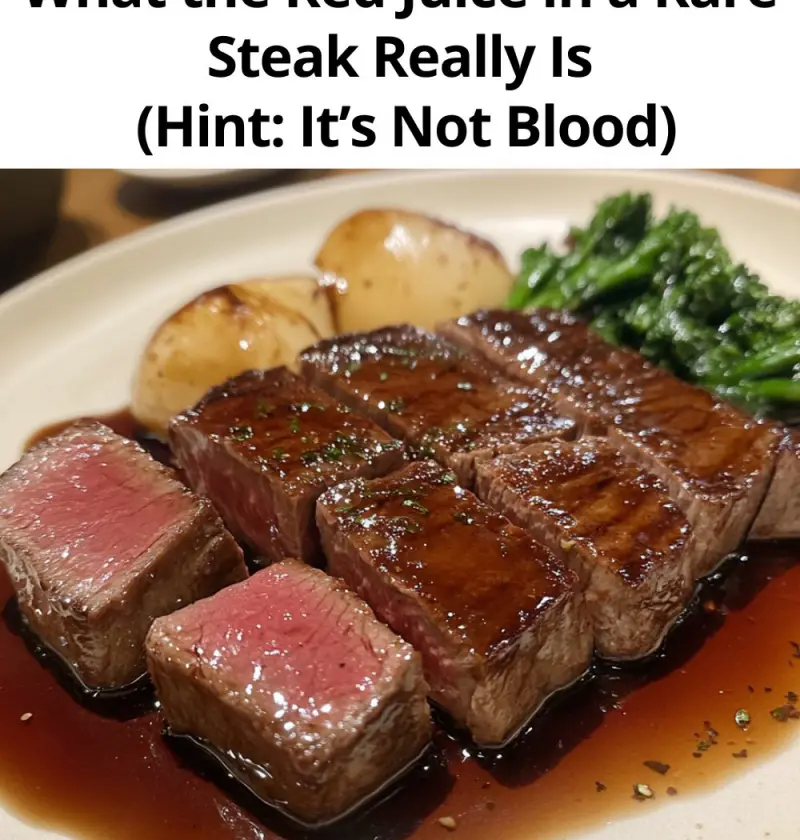For many steak lovers, the sight of a juicy, rare steak is mouthwatering. But for some, that same sight can be off-putting due to a common misconception. The red liquid that oozes out of a rare or medium-rare steak is often mistaken for blood, leading people to assume the steak is undercooked or unsafe to eat. However, this couldn’t be further from the truth. In reality, that red juice has nothing to do with blood—let’s dive into what it really is and why you shouldn’t shy away from it.
What Is the Red Juice in a Rare Steak?
The red juice that you see in a rare steak is actually a mixture of water and a protein called myoglobin, not blood. Myoglobin is present in the muscle tissue of the meat and is responsible for the reddish color of raw and undercooked meat. When the meat is heated during cooking, myoglobin releases water and pigment, which gives the meat its juiciness and appetizing color.
Understanding the Basics of Meat Composition
Meat is primarily composed of three elements: water, protein, and fat. When you cook a steak, these components react differently depending on the temperature and cooking method. Since steak is muscle tissue, it contains a variety of proteins, including myoglobin, which plays a significant role in determining the color and appearance of the meat.
What Is Myoglobin and Why Is It Red?
Myoglobin is a protein found in the muscle fibers of animals, and its primary role is to store oxygen for use during muscle activity. It’s similar to hemoglobin, the protein that carries oxygen in the bloodstream, but myoglobin is specifically found in muscles. This protein contains iron, which binds to oxygen, giving myoglobin its reddish color.
The amount of myoglobin present in meat depends on factors like the animal’s species, age, and activity level. For example, red meats like beef and lamb contain more myoglobin compared to white meats like chicken, which is why red meats tend to have a darker, richer color.
Debunking the Myth: Why It’s Not Blood
Contrary to popular belief, the liquid in your steak is not blood. During the slaughtering process, most of the animal’s blood is drained out. What remains in the meat is primarily water (about 75% of meat’s weight) along with proteins like myoglobin. When you see that red juice pooling on your plate, you’re actually looking at a mixture of water and myoglobin released from the meat’s cells during cooking.
Why the Misconception?
This misconception likely stems from the fact that both blood and myoglobin are red due to their iron content. However, while blood carries oxygen throughout the body via hemoglobin, myoglobin only stores oxygen in muscle tissue. This is why the ‘red juice’ in a rare steak has no connection to blood.
What Happens to Myoglobin During Cooking?
The color of meat changes as it cooks due to transformations in myoglobin:
- Raw Meat: Myoglobin is in its natural state, and the meat appears deep red or purple.
- Rare or Medium-Rare: As the steak heats up to 120-130°F (49-54°C), the myoglobin starts to release water, resulting in the red or pink juice that’s commonly seen in rare steaks.
- Medium to Well-Done: At higher temperatures, the myoglobin’s iron oxidizes, turning it brownish. This is why well-done meat has a grayish-brown color and drier texture.
The amount of myoglobin remaining in the meat determines how red or pink the juices are. As the internal temperature rises, myoglobin is denatured, and the red color gradually disappears, leaving a clear liquid instead.
Why Does Red Meat Contain More Myoglobin?
Different types of meat contain varying amounts of myoglobin, which affects their color and texture:
- Beef: Has a high concentration of myoglobin, giving it a dark red color when raw.
- Lamb: Contains slightly less myoglobin than beef but still has a distinct red hue.
- Pork: Classified as red meat but has a much lower myoglobin content, so it appears lighter.
- Poultry: Chicken and turkey breast have very little myoglobin, making them pale in comparison to red meats.
This difference is why a rare steak appears red and juicy, while rare chicken would not have the same appearance.
Is the Red Juice in a Rare Steak Safe to Eat?
Yes, absolutely! The red juice in a rare steak is not only safe to eat but also a key indicator of its flavor and juiciness. The presence of myoglobin-rich juices means the meat is still tender and full of moisture. Consuming these juices is completely safe and, in fact, beneficial, as myoglobin contains essential nutrients like iron, which is vital for transporting oxygen in your bloodstream.
Tips for Cooking the Perfect Steak
If you want to get the best out of your steak, understanding the role of myoglobin can be helpful. Here are some tips to keep in mind:
- Choose the Right Cut: Cuts with higher myoglobin content, like ribeye or sirloin, will have a richer flavor and more pronounced red juices when cooked to rare or medium-rare.
- Monitor Temperature: Use a meat thermometer to achieve your desired level of doneness. Rare steaks should reach an internal temperature of about 120-130°F (49-54°C).
- Let It Rest: After cooking, let your steak rest for a few minutes. This allows the juices to redistribute throughout the meat, resulting in a more succulent bite.
Enjoying Your Steak with Confidence
Next time you order or cook a rare steak, you can enjoy it with complete confidence. Knowing that the red juice is simply a mixture of water and myoglobin—not blood—helps dispel any fears about undercooked or unsafe meat. Instead, you can focus on the incredible flavors, textures, and nutrients that a well-cooked steak has to offer.
So, the next time someone asks, “What’s that red stuff in my steak?”, you can proudly say it’s not blood—it’s the flavorful, nutritious result of a perfectly cooked piece of meat.
